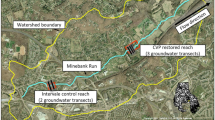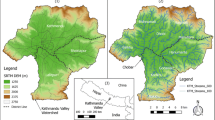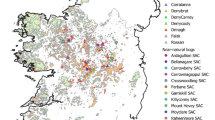Abstract
Carolina Bay wetlands are distinct common components of the Southeastern US Coastal Plain. Many have a history of drainage for agriculture. Restoration of prior-drained Bays can increase P solubility and transport, with potential adverse impacts downstream. To assess risk of off-site P transport, we documented Bay land use, drained area, and proximity to streams and drainageways. We studied Bladen County, NC, where an exhaustive Bay inventory is available. Land-use was documented via classified Landsat decadal images from 1972 through 2010. We compared sequential image pairs to document land-use changes. Phosphorus risk to downstream waters was assessed based on stream proximity, agricultural land use, and arable area. At least 80% of Bays constituting 97% of total Bay area (51,704 ha) exhibited evidence of land-use change. Edges of Bays comprising 80% of Bay coverage were within 15 m of a stream; Bays comprising 13% were isolated. Twenty-one percent of Bay area remained drained in 2010. Prior, 28% of Bay area posed moderate to severe threats to downstream waters; as of 2010, 9%. Considering long-term effects of restoration-induced off-site transport of agrochemicals, land-use history, drained area, and stream/drainageaway proximity should be considered in choosing Bays for restoration.



Similar content being viewed by others
References
Ardón M, Shaena M, Morse JL, Doyle MW, Bernhardt ES (2010a) Phosphorus export from a restored wetland ecosystem in response to natural and experimental hydrologic fluctuations. Journal of Geophysical Research: Biogeosciences 115 https://doi.org/10.1029/2009JG001169.
Ardón M, Shaena M, Morse JL, Doyle MW, Bernhardt ES (2010b) The water quality consequences of restoring wetland hydrology to a large agricultural watershed in the southeastern coastal plain. Ecosystems 13:1060–1078. https://doi.org/10.1007/s10021-010-9374-x
Borggaard OK, Raben-Lange B, Gimsing AL, Strobel BW (2005) Influence of humic substances on phosphate adsorption by aluminium and iron oxides. Geoderma 127:270–279. https://doi.org/10.1016/j.geoderma.2004.12.011
Bruland GL, Hanchey MF, Richardson CJ (2003) Effects of agriculture and wetland restoration on hydrology, soils, and water quality of a Carolina bay complex. Wetlands Ecology and Management 11:141–156. https://doi.org/10.1023/A:1024244408577.
Caldwell PV, Vepraskas MJ, Skaggs RW, Gregory JD (2007) Simulating the water budgets of natural Carolina bay wetlands. Wetlands 27:1112–1123. STWBON]2.0.CO;2
Cintos Research (2018) Collaborative Survey of Carolina Bay Landforms. http://cintos.org/Survey/index.html. Accessed 3 July 2018
Environmental Laboratory (1987) Corps of Engineers Wetland Delineation Manual. US Army Corps of Engineers Wetlands Research Program Technical Report Y-87-1 (on-line edition: https://usace.contentdm.oclc.org/digital/collection/p266001coll1/id/4532/; Accessed 3 July 2018)
Ewing JM, Vepraskas MJ (2006) Estimating primary and secondary subsidence in an organic soil 15, 20, and 30 years after drainage. Wetlands 26:119–130. EPASSI]2.0.CO;2
Ewing JM, Vepraskas MJ, White JG, Broome SW (2012) Chemical soil properties of a Bay wetland after 15, 20, and 30 years of drainage and agricultural production. Geoderma 179-180:73–80. https://doi.org/10.1016/j.geoderma.2012.02.018
Hosen JD, Armstrong AW, Palmer MA (2018) Dissolved organic matter variations in coastal plain wetland watersheds: the integrated role of hydrological connectivity, land use, and seasonality. Hydrological Processes 32:1664–1681. https://doi.org/10.1002/hyp.11519
Lide RF, Meentemeyer VG, Pinder JE, III, Beatty LM (1995) Hydrology of a Carolina Bay located on the upper Coastal Plain of western South Carolina. Wetlands (Wilmington, NC) 15:47–57
McKerrow AJ, Williams SG, Collazo JA (2006) The North Carolina Gap Analysis Project: Final Report. North Carolina Cooperative Fish and Wildlife Research Unit, North Carolina State University, Raleigh, North Carolina. xiv + 110 pp. + appendices
Moorberg CJ, Vepraskas MJ, Niewoehner CP (2013) Dynamics of P dissolution processes in the matrix and rhizospheres of bald cypress growing in saturated soil. Geoderma 202-203:153–160
Moorberg CJ, Vepraskas MJ, Niewhoener CP (2017) Phosphorus dynamics near bald cypress roots in a restored wetland. Soil Science Society of America Journal 81:1652–1660. https://doi.org/10.2136/sssaj2017.07.0228
National Research Council (1995) Wetlands: characteristics and boundaries. National Academy of Sciences press, Washington, D.C.
Pyzoha JE, Callahan TJ, Sun G, Trettin CC, Miwa M (2008) A conceptual hydrologic model for a forested Carolina bay depressional wetland on the coastal plain of South Carolina, USA. Hydrological Processes 22:2689–2698. https://doi.org/10.1002/hyp.6866
Rodriguez AB, Waters MN, Piehler MF (2012) Burning peat and reworking loess contribute to the formation and evolution of a large Carolina-bay basin. Quaternary Research 77:171–181
Schalles JF, Shure DJ (1989) Hydrology, community structure, and productivity patterns of a dystrophic Carolina bay wetland. Ecological Monographs 59:365–385. https://doi.org/10.2307/1943072
Sharitz RR (2003) Carolina bay wetlands: unique habitats of the southeastern United States. Wetlands 23:550–562. CBWUHO]2.0.CO;2
Shenker M, Seitelbach S, Brand S, Haim A, Litaor MI (2005) Redox reactions and phosphorus release in re-flooded soils of an altered wetland. European Journal of Soil Science 56:515–525. https://doi.org/10.1111/j.1365-2389.2004.00692.x
Soil Survey Staff, Natural Resources Conservation Service, United States Department of Agriculture (2018) Soil Survey Geographic (SSURGO) Database. Available online at https://sdmdataaccess.sc.egov.usda.gov. Accessed 6 June 2018
Steinman AD, Ogdahl ME (2011) Does converting agricultural fields to wetlands retain or release P? Journal of the North American Benthological Society 30(3):820–830
Stolt MH, Rabenhorst MC (1987) Carolina bays on the eastern shore of Maryland: II. Distribution and origin. Soil Science Society of America Journal 51:399–405
Sullivan DG, White JG, Vepraskas MJ (2017) Using land-use change, soil characteristics, and a semi-automated on-line GIS database to inventory Carolina bays. Wetlands 37:89–98. https://doi.org/10.1007/s13157-016-0842-8
Surridge BWJ, Heathwaite AL, Baird AJ (2012) Phosphorus mobilisation and transport within a long-restored floodplain wetland. Ecological Engineering 44:348–359. https://doi.org/10.1016/j.ecoleng.2012.02.009
US Congress. 1985. Public Law 99–198. Accessed 20 June 2018. https://www.gpo.gov/fdsys/pkg/STATUTE-99/pdf/STATUTE-99-Pg1354.pdf
USDOC: US Department of Commerce (2010) US Census Bureau, Geography Division TIGER line file. https://www.census.gov/geo/maps-data/data/tiger.html (Accessed 3 July 2018)
USDOD/USEPA. 2008. Compensatory mitigation of losses of aquatic resources. 33 DFR parts 325 and 322; 40 CFR part 230. Available at https://www.epa.gov/sites/production/files/2015-03/documents/2008_04_10_wetlands_wetlands_mitigation_final_rule_4_10_08.pdf. Accessed 20 June 2018
USFWS: US fish and wildlife service (2018) National Wetlands Inventory website. U.S. Department of the Interior, Fish and Wildlife Service, Washington, D.C. http://www.fws.gov/wetlands/ Accessed 3 July 2018
USGS: US Geological Survey (1999) National Elevation Dataset: U.S. Geological Survey Fact Sheet 148–99, 2 p., available only online at https://pubs.usgs.gov/fs/1999/0148/
USGS: US Geological Survey (2018) National Hydrography Datase. http://nhd.usgs.gov. Accessed 6 June 2018
Vepraskas MJ, Huffman RL, Kreiser GS (2006) Hydrologic models for altered landscapes. Geoderma 131:287–298
Vogelmann JE, Howard SM, Limin Y, Larson CR, Wylie BK, Van Driel N (2001) Completion of the 1990s National Land Cover Data set for the conterminous United States from Landsat thematic mapper data and ancillary data sources. Photogrammetric Engineering and Remote Sensing 67:650–662
Weng LP, Riemsdijk v WH, Hiemstra T (2008) Humic nanoparticles at the oxide-water interface: interactions with phosphate ion adsorption. Environmental Science & Technology 42:8747–8752. https://doi.org/10.1021/es801631d
Zamora A (2017) A model for the geomorphology of the Carolina bays. Geomorphology 282:209–216
Acknowledgements
We thank Michael Davias of Cintos Research for assistance with their Collaborative Survey of Carolina Bay Landforms. Our research was funded in part by a grant from the United States Department of Agriculture National Institute of Food and Agriculture.
Author information
Authors and Affiliations
Corresponding author
Rights and permissions
About this article
Cite this article
Sullivan, D.G., White, J.G. & Vepraskas, M. Assessing Carolina Bay Wetland Restoration Risks to Downstream Water Quality by Characterizing Land Use and Stream Proximity. Wetlands 39, 495–506 (2019). https://doi.org/10.1007/s13157-018-1095-5
Received:
Accepted:
Published:
Issue Date:
DOI: https://doi.org/10.1007/s13157-018-1095-5




